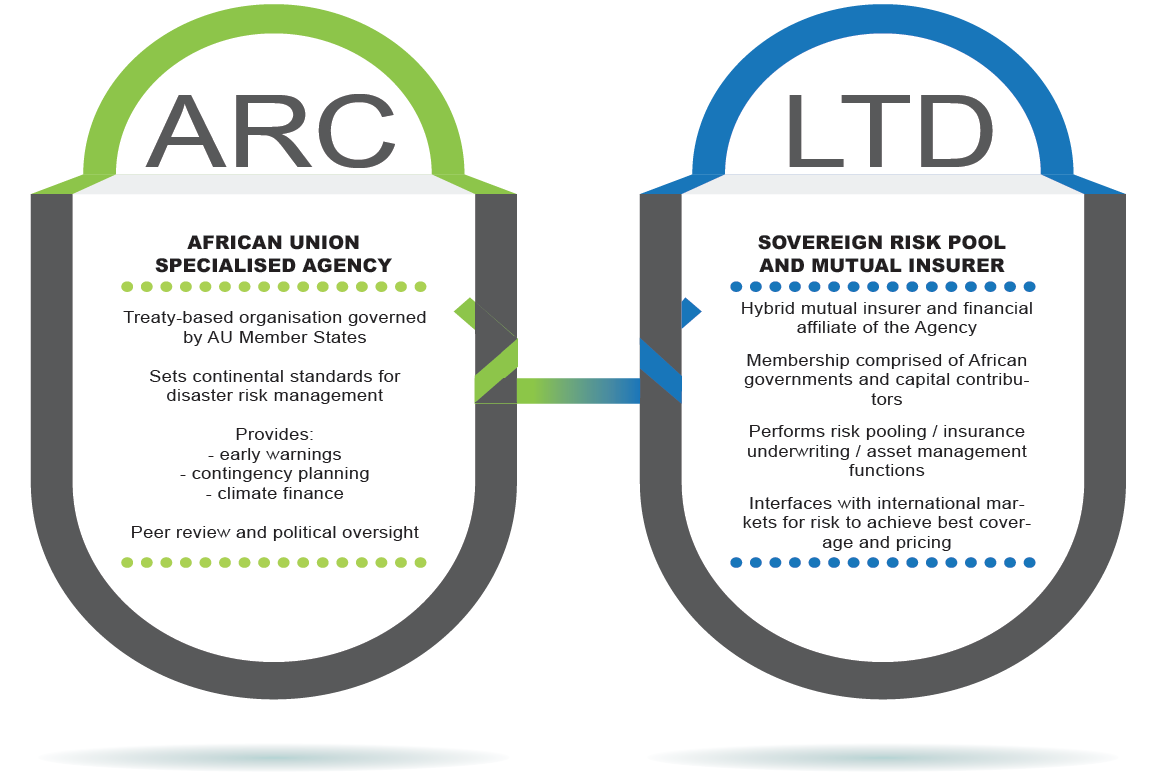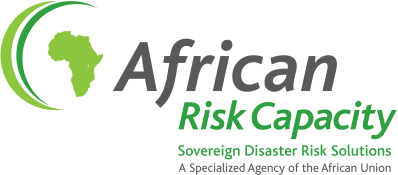How the African Risk Capacity Works
The ARC Group is transforming the way African governments plan, prepare, and respond to natural disasters. By building national capacities, harnessing state-of-the-art technologies to respond, and forging access to innovative finance mechanisms, the organisation offers comprehensive and sustainable solutions to disaster risks.

The ARC Group is composed of two entities: ARC Agency, a Specialised Agency of the African Union, and ARC Insurance Company Limited (ARC Ltd), the financial affiliate of the Group.
ARC Agency is a mechanism that:
- Provides capacity building to ARC Member States in preparation for taking out a policy;
- Provides general oversight and supervision of the development of capacity building services;
- Facilitates the development of country contingency plans and monitors their implementation should a disaster event trigger a payout.
ARC Ltd is the financial affiliate of the Group responsible for carrying out commercial insurance functions of risk pooling and risk transfer in accordance with national regulations for parametric weather insurance.
Through its capacity building and risk pooling services, ARC’s objective is to strengthen the continent’s Disaster Risk Management systems through innovative solutions that take into account the continent's challenges. By capitalising on local and international expertise, and considering the diversification of weather risk across Africa, the ARC offering enables countries to manage their risk as a group in a financially efficient manner in response to probable but uncertain risks. These techniques, while not new, can be applied by African countries in innovative ways to lower the cost of response to disasters before they become humanitarian crises and provide better service to those affected.
Background
Although their exact timing and magnitude are uncertain, most weather events are predictable. Agricultural production in many parts of Africa is affected by natural climate variability and is significantly compromised by climate change which is resulting in higher incidence of drought, floods and tropical cyclones, erratic rainfall, damaging high temperatures.
Drought accounted for an average 36% of all responses between 2002 and 2009. In 2009, the World Food Programme (WFP) assisted 53 million people in sub-Saharan Africa, spending US $2.5 billion – 63% of WFP’s global expenditure that year. By comparison, the Consolidated and Flash Appeal for 2009, which covered all sectors, required over US $6 billion for Africa, of which approximately US$ 4.5 billion was received.
As an example, initial analysis by ARC suggested that a widespread catastrophic drought in sub-Saharan Africa at the time would cost upwards of US $3 billion in emergency assistance. Without doubt, this would put an unprecedented financial strain on African countries and donor countries’ aid budgets.
Before the introduction of the ARC mechanism and in the absence of parametric insurance, responding to natural disasters was largely reactive and relied on international flash appeals to secure funding after a disaster, making it untimely and inequitable, with much of the costs borne by farmers. Under these conditions, governments are forced to reallocate funds from essential development activities in their national budgets to crisis response. Only then can relief be mobilised towards the people who need it most – and it is often too late. In the process, lives may be lost, assets depleted, and development gains reversed – forcing more people into chronic hunger, malnutrition and destitution across the continent.
Contingent funds linked to early warning systems and appropriate contingency plans linked with credible national response mechanisms offer the best solution for delivering more effective and efficient responses to weather shocks in the short term, and can facilitate longer-term investments in increasing food security, disaster risk reduction and climate resilience. By shifting from the old paradigm of a reactive approach to responding to disasters, Africa can move towards better management of its risks that is more economical, more efficient, and saves lives and livelihoods. ARC was founded to catalyse a better risk management system for Africa and provide the capacity building support required to implement such a system.
How it Works
The ARC Group is composed of two entities: ARC Agency, a Specialised Agency of the African Union, and ARC Insurance Company Limited (ARC Ltd), the financial affiliate of the Group. ARC Agency is a cooperative mechanism responsible for providing general oversight of the programme and provision of capacity building services to Member States; approving country-owned contingency plans and monitoring their implementation in the event of a payout. On the other hand, ARC Ltd carries out commercial insurance functions of risk pooling and risk transfer in accordance with national regulations for parametric weather insurance in Bermuda (where it is located until such time that an equally favourable legal and regulatory regime exists in an AU Member State – See Article 11 of the Establishment Agreement).
As an insurance risk pool, ARC’s objective is to capitalise on the natural diversification of weather risk across Africa, allowing countries to manage their risk as a group in a financially efficient manner to respond to probable but uncertain risks. These techniques, while not new, can be applied by African countries in innovative ways to lower the cost of the response to disasters before they become humanitarian crises, and provide better services to those affected.
- The initial capital came from participating countries’ premiums as well as one-time partner contributions;
- ARC works with countries to calculate country premiums and allocate payouts to member countries based on predetermined and transparent rules for payment;
- Countries select the level at which they wish to participate by selecting the amount of risk they wish to retain and financing they want from ARC for risks of varying severity. (ARC is in the process of diversifying its product for other hazards, including floods, at a later date.)
- Operations plans, which show the use of a potential payout, are meant to optimise ARC disbursements and are a prerequisite for participating in ARC risk pools. These take into account existing mechanisms, priorities and needs of each participating government, and are evaluated by the ARC Board’s Peer Review Mechanism according to standards set by the Conference of the Parties;
- The pool reinsures itself as well as benefits from investment income such that it builds and protects the capital available for coverage to member governments.
Early Intervention
ARC payouts arrive in the national treasury within 2-4 weeks of harvest so that the first assistance can reach needy households within 120 days – the time period at which asset depletion at the household level begins. Experts from the University of Oxford and the International Food Policy Research Institute (IFPRI) conducted a cost-benefit analysis (CBA) to examine the economic advantages and disadvantages of establishing a risk pooling facility as an early response mechanism to severe drought in sub-Saharan Africa. A further analysis by the Boston Consulting Group shows the potential benefit of ARC outweighs the estimated cost of running ARC by 4.4 times compared to traditional emergency appeals for assistance, as a result of reduced response times and risk pooling. This means one dollar spent on early intervention through ARC saves four and a half dollars spent after a crisis is allowed to evolve.
Risk Pooling and Risk Transfer
The ARC risk pool combines the risk of a disaster occurring across several countries to take advantage of the natural diversity of weather systems across Africa. That pool then takes on the risk profile of the group rather than the risk profile of each individual country, combining the uncertainty of individual risks into a calculable risk for the group. Since it is unlikely that droughts will occur in the same year in all parts of the continent, not every country participating in the pool will receive a payout in a given year. Because a continental risk pool’s exposure to covariant drought risk would be significantly smaller than a given country’s or region’s exposure, an ARC pool could manage drought risk with fewer funds than if each country financially prepared for its own worst case drought scenario individually.
Indeed, preliminary findings indicate potential savings of 50% from diversification of drought-related losses across Africa, i.e. a 50% reduction in the contingent funds needed if the risk is pooled among nations and managed as a group rather than borne by each country individually. Approaching the market as a group will therefore significantly reduce the individual premiums required to maintain the solvency of the facility. These are savings that can then be invested in longer term development projects and resilience-building activities.
How do Countries Participate in ARC?
As an insurance-based proposition, ARC is not appropriate for managing risks that happen every year. Countries that participate in ARC will be participating in an index-based insurance mechanism for infrequent, severe drought events. In order to participate in ARC, countries must undertake several processes, including customizing the Africa RiskView software, signing MOUs for in-country capacity building, defining a contingency plan for ARC payouts, and determining risk transfer parameters.
When countries have satisfactorily completed this process, they will receive a Certificate of Good Standing from the ARC Agency Governing Board, and will pay a premium to ARC Ltd, after which they will be members of the risk pool.
How a Country Gets a Payout
Members of the ARC risk pool receive a payout when the rainfall deviation is sufficiently severe such that the estimated response costs – estimated by Africa RiskView – cross a certain pre-defined threshold. When that threshold is crossed, qualifying risk pool members receive a payout within 2-4 weeks of the end of the rainfall season, thereby allowing them to begin early intervention programmes before vulnerable populations take negative coping actions.
The payout threshold is determined by the risk transfer parameters selected by each country. Specifically, governments select the deductible/attachment point (the risk the country wants to retain and manage using other resources), the limit (the maximum payout a country can receive in the case of an extreme drought), and the ceding percentage (the percentage of the total modelled risk the country wishes to transfer to the pool) to customise their participation profile. These parameters will determine the premium amount and potential payout levels by each member of the risk pool.
The ARC currently offers a maximum coverage of US $30 million per country per season for drought events that occur with a frequency of 1 in 5 years or less.





